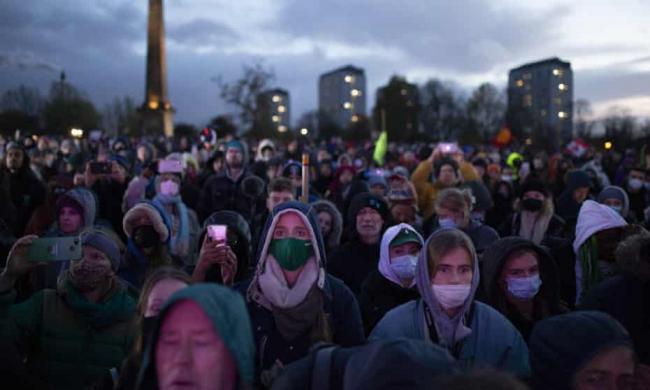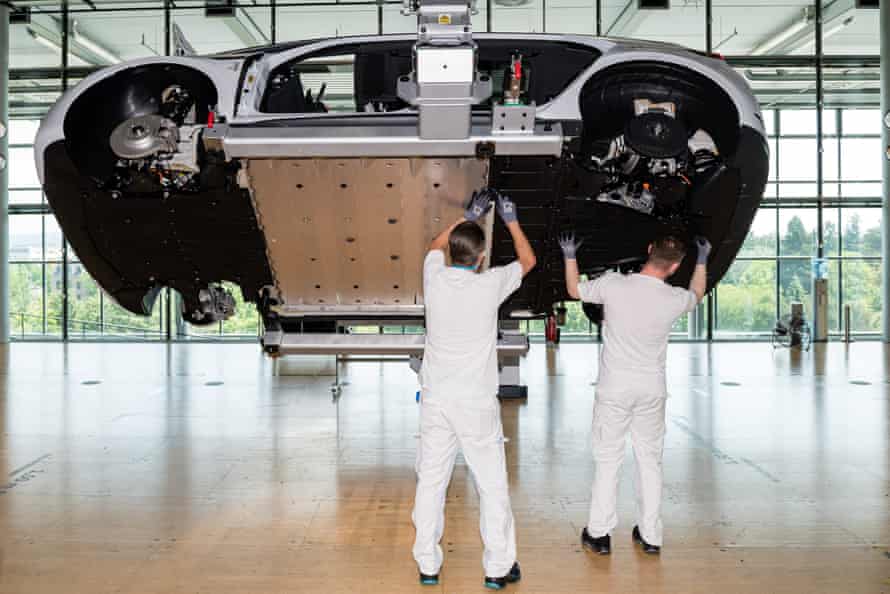Articles Menu

Nov. 14, 2021
Now it’s a straight fight for survival. The Glasgow Climate Pact, for all its restrained and diplomatic language, looks like a suicide pact. After so many squandered years of denial, distraction and delay, it’s too late for incremental change. A fair chance of preventing more than 1.5C of heating means cutting greenhouse gas emissions by about 7% every year: faster than they fell in 2020, at the height of the pandemic.
What we needed at the Cop26 climate conference was a decision to burn no more fossil fuels after 2030. Instead, powerful governments sought a compromise between our prospects of survival and the interests of the fossil fuel industry. But there was no room for compromise. Without massive and immediate change, we face the possibility of cascading environmental collapse, as Earth systems pass critical thresholds and flip into new and hostile states.
So does this mean we might as well give up? It does not. For just as the complex natural systems on which our lives depend can flip suddenly from one state to another, so can the systems that humans have created. Our social and economic structures share characteristics with the Earth systems on which we depend. They have self-reinforcing properties – that stabilise them within a particular range of stress, but destabilise them when external pressure becomes too great. Like natural systems, if they are driven past their tipping points, they can flip with astonishing speed. Our last, best hope is to use those dynamics to our advantage, triggering what scientists call “cascading regime shifts”.
A fascinating paper published in January in the journal Climate Policy showed how we could harness the power of “domino dynamics”: non-linear change, proliferating from one part of the system to another. It points out that “cause and effect need not be proportionate”, a small disturbance, in the right place, can trigger a massive response from a system and flip it into a new state. This is how the global financial crisis of 2008-09 happened: a relatively minor shock (mortgage defaults in the US) was transmitted and amplified through the entire system, almost bringing it down. We could use this property to detonate positive change.
Sudden shifts in energy systems have happened before. The paper points out that the transition in the US from horse-drawn carriages to cars running on fossil fuels took just over a decade. The diffusion of new technologies tends to be self-accelerating, as greater efficiencies, economies of scale and industrial synergies reinforce each other. The authors’ hope is that, when the penetration of clean machines approaches a critical threshold, and the infrastructure required to deploy them becomes dominant, positive feedbacks will rapidly drive fossil fuels to extinction.
For example, as the performance of batteries, power components and charging points improves and their costs fall, the price of electric cars drops and their desirability soars. At this point (in other words, right now), small interventions by government could trigger cascading change. This has already happened in Norway, where a change in taxes made electric vehicles cheaper than fossil-fuel cars. This flipped the system almost overnight: now more than 50% of the nation’s new car sales are electric, and petrol models are heading for extinction.
As electric cars become more popular, and more polluting vehicles become socially unacceptable, it becomes less risky for governments to impose the policies that will complete the transition. This then helps to scale the new technologies, causing their price to fall further, until they outcompete petrol cars without the need for tax or subsidy, locking in the transition. Driven by this new economic reality, the shift then cascades from one nation to another.

The battery technologies pioneered in the transport sector can also spread into other energy systems, helping to catalyse regime shifts in, for example, the electricity grid. The plummeting prices of solar electricity and offshore wind – already cheaper than hydrocarbons in many countries – are making fossil fuel plants look like a filthy extravagance. This reduces the political costs of accelerating their closure through tax or other measures. Once the plants are demolished, the transition is locked in.
Of course, we should never underestimate the power of incumbency, and the lobbying efforts that an antiquated industry will use to keep itself in business. The global infrastructure of fossil fuel extraction, processing and sales is worth somewhere between $25tn (£19tn) and $0, depending on which way the political wind is blowing. The fossil fuel companies will do everything in their power to preserve their investments. They have tied President Joe Biden’s climate plans in knots. It would be no surprise if they were talking urgently with Donald Trump’s team about how to help lever him back into office. And if they can thwart action for long enough, the eventual victory of low-carbon technologies might scarcely be relevant, as Earth’s systems could already have been pushed past their critical thresholds, beyond which much of the planet could become uninhabitable.
But let’s assume for a moment that we can shove the dead weight of these legacy industries aside, and consign fossil fuels to history. Will that really have solved our existential crisis? One aspect of it, perhaps. Yet I’m dismayed by the narrowness of the focus on carbon, in the Glasgow pact and elsewhere, to the exclusion of our other assaults on the living world.
Electric cars are a classic example of the problem. It’s true that within a few years, as the advocates argue, the entire stinking infrastructure of petrol and diesel could be overthrown. But what is locally clean is globally filthy. The mining of the materials required for this massive deployment of batteries and electronics is already destroying communities, ripping down forests, polluting rivers, trashing fragile deserts and, in some cases, forcing people into near-slavery. Our “clean, green” transport revolution is being built with the help of blood cobalt, blood lithium and blood copper. Though the emissions of both carbon dioxide and local pollutants will undoubtedly fall, we are still left with a stupid, dysfunctional transport system that clogs the streets with one-tonne metal boxes in which single people travel. New roads will still carve up rainforests and other threatened places, catalysing new waves of destruction.

A genuinely green transport system would involve system change of a different kind. It would start by reducing the need to travel – as the mayor of Paris, Anne Hidalgo, is doing with her 15-minute city policy, which seeks to ensure that people’s needs can be met within a 15-minute walk from homes.
It would encourage walking and cycling by all who are able to do so, helping to address our health crisis as well as our environmental crisis. For longer journeys, it would prioritise public transport. Private electric vehicles would be used to address only the residue of the problem: providing transport for those who could not travel by other means. But simply flipping the system from fossil to electric cars preserves everything that’s wrong with the way we now travel, except the power source.
Then there’s the question of where the money goes. The fruits of the new, “clean” economy will, as before, be concentrated in the hands of a few: those who control the production of cars and the charging infrastructure; and the construction companies still building the great web of roads required to accommodate them. The beneficiaries will want to spend this money, as they do today, on private jets, yachts, extra homes and other planet-trashing extravagances.
It is not hard to envisage a low-carbon economy in which everything else falls apart. The end of fossil fuels will not, by itself, prevent the extinction crisis, the deforestation crisis, the soils crisis, the freshwater crisis, the consumption crisis, the waste crisis; the crisis of smashing and grabbing, accumulating and discarding that will destroy our prospects and much of the rest of life on Earth. So we also need to use the properties of complex systems to trigger another shift: political change.
There’s an aspect of human nature that is simultaneously terrible and hopeful: most people side with the status quo, whatever it may be. A critical threshold is reached when a certain proportion of the population change their views. Other people sense that the wind has changed, and tack around to catch it. There are plenty of tipping points in recent history: the remarkably swift reduction in smoking; the rapid shift, in nations such as the UK and Ireland, away from homophobia; the #MeToo movement, which, in a matter of weeks, greatly reduced the social tolerance of sexual abuse and everyday sexism.
But where does the tipping point lie? Researchers whose work was published in Science in 2018 discovered that a critical threshold was passed when the size of a committed minority reached roughly 25% of the population. At this point, social conventions suddenly flip. Between 72% and 100% of the people in the experiments swung round, destroying apparently stable social norms. As the paper notes, a large body of work suggests that “the power of small groups comes not from their authority or wealth, but from their commitment to the cause”.
Another paper explored the possibility that the Fridays for Future climate protests could trigger this kind of domino dynamics. It showed how, in 2019, Greta Thunberg’s school strike snowballed into a movement that led to unprecedented electoral results for Green parties in several European nations. Survey data revealed a sharp change of attitudes, as people began to prioritise the environmental crisis.
Fridays for Future came close, the researchers suggest, to pushing the European political system into a “critical state”. It was interrupted by the pandemic, and the tipping has not yet happened. But witnessing the power, the organisation and the fury of the movements gathered in Glasgow, I suspect the momentum is building again.
Social convention, which has for so long worked against us, can if flipped become our greatest source of power, normalising what now seems radical and weird. If we can simultaneously trigger a cascading regime shift in both technology and politics, we might stand a chance. It sounds like a wild hope. But we have no choice. Our survival depends on raising the scale of civil disobedience until we build the greatest mass movement in history, mobilising the 25% who can flip the system. We do not consent to the destruction of life on Earth.
[Top photo: Demonstrators at the Cop26 climate talks in Glasgow, Saturday 6 November Photograph: Bloomberg/Getty Images]